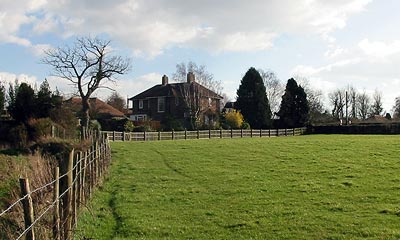Self Build Services
Water & Sewage
As with the majority of the services you require the supplier will normally provide a free quotation for the strConection of their service. The water companies will provide mains water to your site and install a meter normally close to the highway.
You will then need to lay your own water pipe to the water main is blue plastic pipe that comes in a large roll and should be laid at least 750mm below ground level to avoid frost damage. Try and avoid having joints underground, as leaks will be costly to put right. You will need to duct the pipe where it comes into the building and also lag the pipe to avoid frost damage.

There are several ways of disposing of foul water; the most common is simply to strConect to the main drains for the town or village usually located in the road outside the site. The other method is either septic tank or cesspool.
Gas
The gas company will need to survey the site for access but the cost for gas installation is fairly low, the gas company will normally provide you with a meter box free of charge that you can build into an exterior wall allowing easy access for meter reading. If gas is not available, you can always consider LP gas.
Electricity
As with the other service providers use the facility of a free quotation for installation, the further you are away from the main supply the more expensive. Your regional Electric Company should be able to provide you with an exterior meter box for you to build in, again allowing easy access for meter reading.
Telephone & Cable
Phone & cable TV is probably the cheapest service to have installed. British Telecom normally charge £99 to strConect a residential property and the new cable companies often strConect free of charge if you have cable TV as well. A free quotation should alleviate any problems.
Foundations
There are many types of foundations that can be used when constructing your home; in our example house we have used the trench fill method which involves pulling trenches with a machine and filling with concrete to just below ground level.
Your Architect or structural engineer will have designed the appropriate foundations governed by the ground conditions on site and your local building control office will have passed these. The building control officer will inspect the trench and when happy with the ground conditions will allow you to pour the foundations.
Other types of foundation that can be used are traditional strip foundations, this is similar to trench fill in that a 1m deep trench is dug by machine but instead of filling the trench with concrete only the bare minimum of concrete is used and then brick and blockwork are raised to the surface.
Another method is to use a raft foundation were the foundation and floor slab are poured as one with extensive use of reinforcing. This method is favored where ground conditions are poor and allows the whole structure to float on the raft foundation. The cost of a raft foundation is quite expensive compared to normal trench fill but would compare in price to pile foundations.
The alternative method to pouring wet concrete is to use the block and beam method that consists of pre-stressed concrete tee beams, in filled with blocks and then screeded.
Developers favour this method as it allows for rapid application and can be very cost effective if you can order large quantities of blocks, which should not be a problem if you are doing a traditional build as you use the same blocks for the internal walls. This method can also be used for the first floor construction, but on large room spans the beams may well need to be crane lifted into position that could prove to be expensive.
External Walls
There are numerous ways of either cladding the outer leaf or constructing the external walls, in our example house we have used a standard grade facing brick. The price of bricks can vary dramatically depending on style.
When looking at the external finish of a house remember that approximately 20% of the face area of a wall, if bricks are used will be the mortar, so care must be taken when choosing the colour of the mortar as this can often change the entire appearance of a wall. If you use coloured mortar mix, it can often be best to order in pre-mixed mortar ready to use, thus maintaining a perfect colour match throughout the entire wall area.
There are many other methods of cladding the outer skin of a building, such as stone, render, wood or plastic cladding or even vertical hung tiles. The decision is often out of your hands and may well be dictated by the local planners depending on local conditions or availability of local materials.
Many new houses have part brickwork and render panels so you could always mix and match different materials.
At the end of the day you will probably have to compromise between what you want and what the planners will allow in your locality.
First Floor
The first floor can be constructed in several different ways; one way is similar to the ground floor using the concrete block and beam design that consists of using pre-stressed concrete tee beams, infilled with blocks and then screeded.
The only draw back using this method for first floor construction is if the beams are fairly long you will probably need a crane to lift them into position. The big advantage is this is a rapid way of placing the first floor and provides a very good working platform for the rest of the build to continue.
The most common method used in constructing the first floor would be the use of 200mm x 50mm timber joists built in to the walls either end or supported on joist hangers with 18mm tongued and grooved chipboard used as flooring. Herringbone strutting gives lateral support to the joists preventing twisting. 12.5mm foil backed plasterboard is used for added insulation value.
An alternative product on the market is the laminated timber joist, this has the advantage of being smaller in section and a great deal lighter to handle. With the new joists being manufactured to a uniform size this will help eliminate the age-old problem of squeaky floors.
There is a vast array of different types of flooring that can be used on the first floor.
As previously mentioned, the most common type of flooring is tongued and grooved chipboard, this is made in sheets of 4' x 2' (1.2m x 600mm) and would be fixed down with either screws or nails with the joints glued. Waterproof Chipboard normally green in colour would be used on the bathroom floor.
A very popular product now is laminated hardwood flooring, produced in boards, it's easily laid over a foam underlay on a chipboard base. This produces a polished hardwood floor at a very competitive price.
The cost for this section is approximately 6% of build cost £4,860.
Roof
Truss manufacturers will design your trusses and provide structural calculations. The trusses are then delivered free of charge and crane off loaded on site.
Care should be taken when storing trusses on site, your manufacturer will advise on the best means of storage or have the trusses delivered and erected straight away. The trusses are placed on timber wall plates fixed and braced in position, then covered with felt, batten and tiled.
The other common method of roof construction is a hand cut roof, this type of roof as the name implies is hand cut on site by the carpenter from sawn carcassing purchased from your local supplier.
The carpenter will need full structural calculations and drawings in order to construct the roof. This type of roof is normally used if there is a complicated shape or a delay in getting the trusses manufactured in time.
Although the hand cut roof will probably take longer to erect there is little difference in the overall price as money spent on buying in pre-made trusses will be spent on labour of the carpenter to cut the roof.
The final roof covering may well have been decided for you buy the planners, but if the choice is up to you, a great deal of thought will need to go into this as the roof is such a vast area and will have a very big impact on the overall look of the completed house. With both colour and type of tile making a vast difference.
Central heating
There are numerous types of boilers and heating systems available. On average you will require 25 watts of heat per cubic metre of living space.
There are many different designs of boilers now appearing in the market place using new technology to improve efficiency, it is well worth considering using a heating and ventilating consultant to design a system most suited to your needs.
Plumbing
The choice of plumbing parts is really the choice between copper or plastic. A great deal of care should be taken when designing pipe runs so as to minimise the quantity of materials used and eliminate problems of blockages in waste pipes and noise in water pipes.
The use of modern plastic piping and push fit fittings can greatly reduce cost, offering large savings on time and effort installing long runs of pipe work. Without the need to use heat, installing the plastic pipes is much quicker and cleaner with far less risk of fire.
Electrical work
The consumer unit has now replaced the old fuse box with miniature circuit breakers (MCBs) instead of fuses.
Consumer units come in a variety of sizes, a 10 gang unit should be ample for most houses. Most consumer units come with a residual circuit breaker built in, further protection against electric shock.
When planning the layout of your rooms in the house always put in plenty of sockets it's far cheaper now rather than trying to add in extra sockets later. Don't forget the garden socket and lights, the loft, porch and outside lights and the light under the stairs.
External works
The external works will normally be the first thing any visitors to your new home will see, and will be the first impression they have of your dream home.
Always allow plenty of time planning the layout of your garden, a badly laid out garden can spoil a superbly built house. There will always be far more mess and rubbish to remove from site than you could ever imagine, so build in a contingency sum to clean the site and landscape the garden. Allow for fences; drive ways, brick walls, patios, gates, sheds/outbuildings, landscaping and turfing.
Continue Reading: Timber Frame Homes
September 2004
